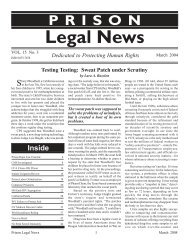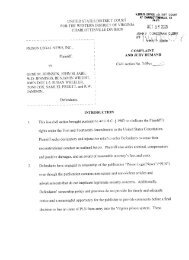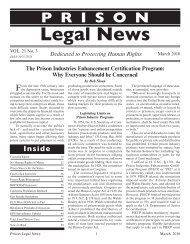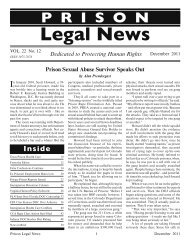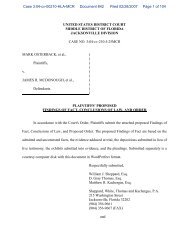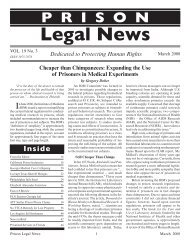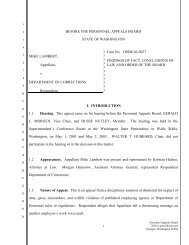From the Editor - Prison Legal News
From the Editor - Prison Legal News
From the Editor - Prison Legal News
Create successful ePaper yourself
Turn your PDF publications into a flip-book with our unique Google optimized e-Paper software.
Cost Shifting (cont.)<br />
www.census.gov/prod/2006pubs/p60-231.pdf.<br />
31 Id.<br />
32 The Census Bureau uses a set of money<br />
income thresholds that vary by family size and<br />
composition to determine who is in poverty. For<br />
example, a family of four that includes two related<br />
children under 18 <strong>the</strong> threshold amount is $19,806.<br />
Income above this amount means <strong>the</strong> family is not<br />
in poverty, while income below <strong>the</strong> sum means <strong>the</strong><br />
family is in poverty. For a list of <strong>the</strong> poverty thresholds<br />
in 2005, see Carmen DeNavas-Walt, Bernadette<br />
D. Proctor & Cheryl Hill Lee, U.S. Census Bureau,<br />
Income, Poverty, and Health Insurance Coverage in<br />
<strong>the</strong> United States: 2005, 45 (2006), available at http://<br />
www.census.gov/prod/2006pubs/p60-231.pdf.<br />
33 Id. at 13-15.<br />
34 Id. at 13-14.<br />
35 As early as 1988, <strong>the</strong> National Institute<br />
of Corrections observed that economic sanctions<br />
against people involved in <strong>the</strong> criminal justice system<br />
were expanding. Economic Sanctions Report at 1.<br />
The number of states charging a probation fee, for<br />
example, grew from 9 in 1980 to 24 in 1986. Id.<br />
36 730 Ill. Comp. Stat. 5/5-5-10.<br />
37 Kan. Stat. Ann. § 22-4529.<br />
38 Minn. Stat. Ann. § 611.27.<br />
39 Jon Wool & Don Stemen, Vera Institute of<br />
Justice, Changing Fortunes or Changing Attitudes?<br />
Sentencing and Corrections Reforms in 2003, 4<br />
(2004).<br />
40 Karen Imas & Rachel McLean, The Council<br />
of State Governments Eastern Regional Conference,<br />
Issue Brief, “Policymakers Discuss Practical<br />
Solutions to Financial Obligations of People Released<br />
from <strong>Prison</strong>s and Jails,” 2-3, May 2006. NIC<br />
expressed this sentiment twenty years earlier in <strong>the</strong><br />
Economic Sanctions Report: “Concurrent with<br />
<strong>the</strong>se leaps has been an incremental growth resulting<br />
from <strong>the</strong> piecemeal adoption of fees, program by<br />
program, agency by agency.” Economic Sanctions<br />
Report at 1.<br />
41 Lauren E. Glaze & Thomas P. Bonczar,<br />
U.S. Dep’t of Justice, Bureau of Justice Statistics,<br />
Probation and Parole in <strong>the</strong> United States, 2005,<br />
1 (2006), available at http://www.ojp.usdoj.gov/bjs/<br />
pub/pdf/ppus05.pdf.<br />
42 Economic Sanctions Report at iv.<br />
43 Economic Sanctions Report at iv.<br />
44 “In New York, and all across <strong>the</strong> country,<br />
state legislatures are increasing existing fees, fines,<br />
45<br />
April 2008<br />
and surcharges and creating new ones. Parole and<br />
probation supervision fees, surcharges for convictions<br />
of violations, misdemeanors, and felonies,<br />
incarceration fees, and DNA databank fees are all<br />
examples of financial penalties.” Center for Community<br />
Alternatives, “Sentencing for Dollars: Policy<br />
Considerations,” available at http://www.communityalternatives.org/articles/policy_consider.html.<br />
45 Gabriel Jack Chin & Margaret Colgate<br />
Love, Introduction to Symposium on <strong>the</strong> Collateral<br />
Sanctions in Theory and Practice, 36 U. Tol.<br />
L. R. ix (2005) available at http://law.utoledo.edu/<br />
students/lawreview/volumes/v36n3/index.htm. The<br />
American Bar Association recently recommended<br />
that state “legislature[s] should collect, set out<br />
or reference all collateral sanctions in a single<br />
chapter or section of <strong>the</strong> jurisdiction’s criminal<br />
code” in order to “provide <strong>the</strong> means by which<br />
information concerning <strong>the</strong> collateral sanctions<br />
that are applicable to a particular offense is readily<br />
available.” Am. Bar. Ass’n, Standards for Criminal<br />
Justice Section Standards, Collateral Sanctions<br />
and Discretionary Disqualification of Convicted<br />
Persons, Standards §§ 19-2.1, 19-1.2(a)(iii) (2006),<br />
available at http://abanet.org/crimjust/standards/<br />
collateral_blk.html.<br />
46 Economic Sanctions Report at vii-viii.<br />
47 For example in Washington “‘cost of<br />
incarceration’ means <strong>the</strong> cost of providing an inmate<br />
with shelter, food, clothing, transportation,<br />
supervision, and o<strong>the</strong>r services and supplies as may<br />
be necessary for <strong>the</strong> maintenance and support of<br />
<strong>the</strong> inmate while in custody of <strong>the</strong> department . . .”<br />
Dean v. Lehman, 18 P.3d 523, 533 (Wash. 2001).<br />
48 Mark H. Bergstrom & R. Barry Ruback,<br />
Economic Sanctions in Criminal Justice: Purposes,<br />
Effects and Implications, 33 Crim. Justice & Behav.<br />
242, 249 (2006).<br />
49 Id. at 250.<br />
50 According to <strong>the</strong> U.S. Department of<br />
Justice Office for Victims of Crime, “nearly every<br />
state has some form of general offender assessment,<br />
penalty, or surcharge that all convicted defendants<br />
must pay” that goes to funds set aside for victim<br />
services or compensation. U.S. Dep’t of Justice,<br />
Office for Victims of Crime, “State Legislative Approaches<br />
to Funding for Victims’ Services,” <strong>Legal</strong><br />
Series Bulletin #9, 1 (2003), available at http://<br />
www.ojp.usdoj.gov/ovc/publications/bulletins/<br />
legalseries/bulletin9/ncj199477.pdf.<br />
51 Lauren E. Glaze & Thomas P. Bonczar,<br />
U.S. Dep’t of Justice, Bureau of Justice Statistics,<br />
Probation and Parole in <strong>the</strong> United States, 2005, 1<br />
(2006), available at http://www.ojp.usdoj.gov/bjs/<br />
pub/pdf/ppus05.pdf.<br />
52 Paige M. Harrison & Allen J. Beck, U.S.<br />
Dep’t of Justice, Bureau of Justice Statistics, <strong>Prison</strong>ers<br />
in 2005, 1 (2006), available at http://www.ojp.<br />
usdoj.gov/bjs/pub/pdf/p05.pdf.<br />
53 Id.<br />
54 See fn. 66.<br />
12<br />
55 Id.<br />
56 Id.<br />
57 Id. at 6, tbl. 2.<br />
58 Id. at 9, tbl. 6.<br />
59 Barbara Krauth & Karin Stayton, U.S. Dept’<br />
of Justice, Nat’l Inst. of Corr., Fees Paid by Jail Inmates:<br />
Fee Categories, Revenues, and Management<br />
Perspectives in a Sample of U.S. Jails, 1 (Connie Clem,<br />
ed., 2005) (hereinafter referred to as “NIC Jail Fees<br />
Report”), available at http://nicic.org/Downloads/<br />
PDF/Library/021153.pdf.<br />
60 Id. at 4. “Responses were received from jurisdictions<br />
in 28 states and <strong>the</strong> District of Columbia.<br />
. . .” Id.<br />
61 NIC Jail Fees Report at 6.<br />
62 NIC Jail Fees Report at 15.<br />
63 Id. at 15-16.<br />
64 NIC Jail Fees Report at 2. Id.<br />
65 U.S. Dep’t of Justice, Nat’l Inst. of Corr.,<br />
Fees Paid by Jail Inmates: Findings <strong>From</strong> <strong>the</strong> Nation’s<br />
Largest Jails, Special Issues in Corrections, 2<br />
(February 1997), available at http://www.nicic.org/<br />
pubs/1997/013599.pdf.<br />
66 Kentucky law requires prisoners to reimburse<br />
“costs of confinement.” See Ky. Rev. Stat. Ann. §<br />
441.265 (“a prisoner in a county jail shall be required<br />
by <strong>the</strong> sentencing court to reimburse <strong>the</strong> county for<br />
expenses incurred by reason of <strong>the</strong> prisoner’s confinement<br />
as set out in this section, except for good cause<br />
shown.” Id. § 441.265(1). In Campbell County, jailors<br />
confiscate an initial $20 from an arrestee’s possessions<br />
and subsequently deduct 25 percent daily from inmate<br />
accounts as reimbursement for costs of confinement, up<br />
to $50 per day, and a mandatory $30 “booking fee.” In<br />
neighboring Kenton County, jailors deduct 50 percent<br />
from a prisoner’s account until charges are paid in<br />
full. See Sickles v. Campbell Cty, 439 F. Supp. 2d 751,<br />
752 (E.D. Ky. 2006); see also Plaintiff’s Class Action<br />
Complaint and Jury Demand, Sickles v. Campbell Cty.,<br />
2005 WL 1530654 at 13 (May 17, 2005).<br />
67 Paul A. Long, Judge OKs seizing inmates’<br />
money, Kentucky Post, July 25, 2006.<br />
68 The federal Bureau of <strong>Prison</strong>s requires<br />
prisoners in its facilities to pay <strong>the</strong>ir “cost of incarceration,”<br />
and runs <strong>the</strong> “Inmate Financial Responsibility<br />
Program” (IFRP), which ostensibly “encourages each<br />
sentenced inmate to meet his or her legitimate financial<br />
obligations [by assisting] <strong>the</strong> inmate in developing a<br />
financial plan for meeting those obligations.” Program<br />
Statement: Financial Responsibility Program, Inmate,<br />
U.S. Dep’t of Justice, Federal Bureau of <strong>Prison</strong>s, §<br />
545.10-1 (Aug, 15, 2005). The IFRP requirements<br />
do not apply to pretrial or detainee prisoners. Id. §<br />
545.10-6.<br />
69 18 P.3d 523 (Wash. 2001).<br />
70 Id. at 526. Specifically, it permitted deduction<br />
of 35 percent of such funds, re-routed as follows:<br />
(i) Five percent to <strong>the</strong> public safety and<br />
education account for <strong>the</strong> purpose of crime victims’<br />
compensation;<br />
(ii) Ten percent to a department personal inmate<br />
<strong>Prison</strong> <strong>Legal</strong> <strong>News</strong>



